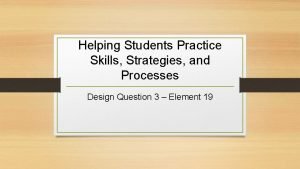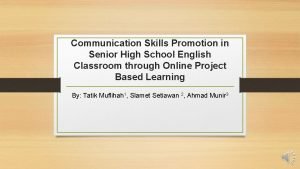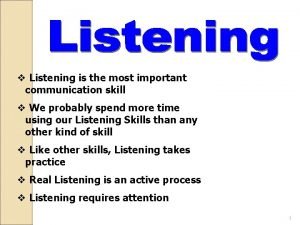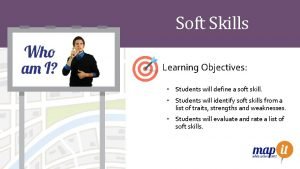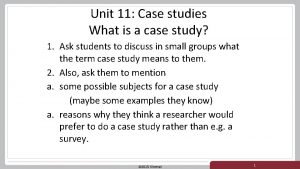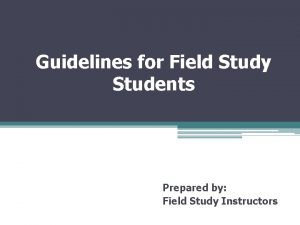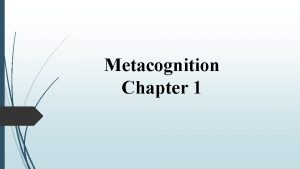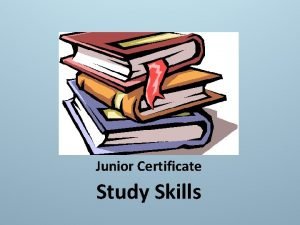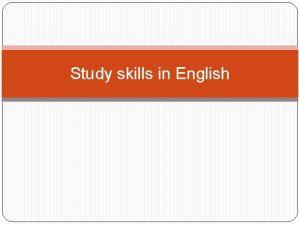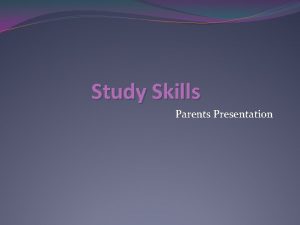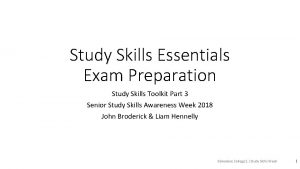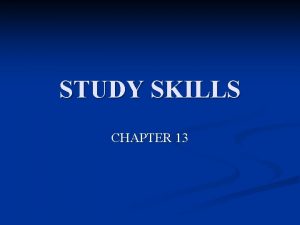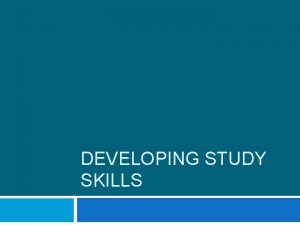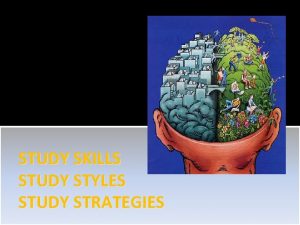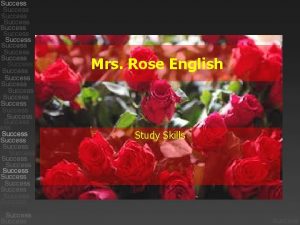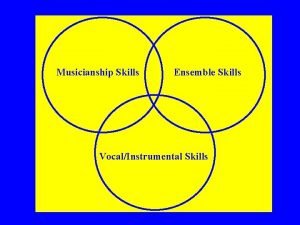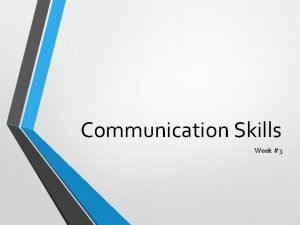Study Skills For Students of English English as



























- Slides: 27

Study Skills For Students of English

English as Your Language of Instruction p. 1 üMotivation üConcentration üDistraction üPlace of Study üTime of Study

Motivation ØInside: ØOutside: Your hopes and expectations Grades (small, artificial steps to ultimate goal)

Concentration 1. How and why is the subject important? 2. How is the subject related to other subjects, other times, places, problems and purposes? 3. Interest depends on understanding

Distraction: How to avoid? • May not have 100% control • Choose your time and place to study • Keep good health

Place of Study • • • To increase efficiency Ideally if you have your private room A desk specifically reserved for studying Quiet environment Optimal lighting and temperature

Time of Study: Plan your work and work your plan • • • 1 or 2 hours early in the morning Definite time schedule Don’t allow your work to accumulate Never cram materials 2 days before exam 1 -hour lesson + 2 -hour study time • Trade time, don’t steal it.

Learning Vocabulary of English p. 47 1. By Phonograms 2. By Guessing meaning from Context 3. By Word Formation a) b) c) d) Prefix + word stem + suffix Changing Parts of Speech Present and past participles as Adjectives Word stems

Recording the Meaning of Words p. 75 • File cards/ Note book – New word on a separate card – Copy meaning, pronunciation, part of speech, usage on 4 columns – Arrange cards alphabetically – Review regularly – Check mark beside difficult word

Writing an Outline: organization of related ideas p. 81 • Useful for : • Analyze ideas when reading (summary of ideas) • Organize ideas when writing (expansion of ideas)

How An Outline Is Written p. 81 1. System of indenting, numbering and lettering 2. Heading: i. Topic Outline ii. Sentence Outline

Outlining Before Writing p. 90 • Expository writing: expose facts or ideas by presenting, explaining, or interpreting • Brainstorming of ideas • Delete irrelevant points • organize your ideas by organizing main ideas and supporting details systematically • One main point=> One paragraph • Descending order of importance

Improving your Reading • • • p. 95 Reading speed Vs Comprehension Achieve a comfortable balance Don’t vocalize words Try pointing at lines but not words Speed increases with a better knowledge of grammar and usage • Speed varies depending on material and purposes of reading • Regression unavoidable

Ways of reducing uncertainty: Predicting p. 100 1. Visual information (by actual looking at it ) 2. Orthographic information (by phonograms) 3. Grammatical information (by rules of grammar) 4. Semantic information ( by logical deduction) 5. Revising if necessary (when more, new information comes up)

Recognizing Paragraph Patterns while Reading p. 122 1. 2. 3. 4. 5. Paragraphs of Analysis Paragraphs of Description Paragraphs of Comparison and Contrast Paragraphs of Analogy Paragraphs of Definition

Paragraphs of Analysis: deductive organization • Function: to analyze a topic • Moves from General to the Particular • Main ideas introduced at the beginning of the paragraph (topic sentence) or as a conclusion at the end • Supporting details: causes, effects, reasons, methods, purposes

Paragraphs of Description • Physical description : general to specific or vice versa • Description of a process: order of sequence, imperatives

Paragraphs of Comparison and Contrast ØMain idea: is it similar or different? ØSupporting details: descriptions+ examples + definitions

Paragraphs of Analogy • Purpose: clarifying an abstract idea by comparing it to a more concrete, visualizable example • Start with a clearly stated Topic sentence • Followed by Comparison to reduce it to a common, easily comprehended situation for better understanding.

Paragraphs of Definition • Purposes: define, explain, clarify the meaning • Includes: analysis, comparison or contrast, description, an analogy • Main idea: topic sentence at the beginning or as conclusion at the end

Reference • Relate ideas to each other • Signals syntactic or semantic connection within and between sentences • Can refer back to ideas mentioned, or forward to ideas yet to be stated

Connectives p. 130 • Better understanding increases reading speed • Helps prediction of the subsequent ideas in reading • Helps flow and elaboration of ideas when writing

Functions of Connectives Signal Results: consequently, accordingly Signal Contrast: nevertheless, in spite of Signal Addition: in addition, furthermore Signal Examples: for instance Signal Series or Time Sequence: to begin with, finally

Making Good Notes 1. 2. 3. 4. p. 185 Requires active participation Demands full attention Be alert to the thought of speaker Be able to differentiate important ideas

How to keep a note book 1. 2. 3. 4. Use an outline Use a large loose-leaf notebook Use ink, colour pencils for visual effect Title each page with course name and date 5. Leave wide margin on the left or right for review

Purpose of making notes • Guide you through carefully through the course (Outline) • Aid your thinking by referring to the main points (Highlight) • Remind you later the development and relationship of essential ideas (Macro view of idea: -Mind Map)

How to make notes effectively? Ω Distinguish the relative importance of ideas, facts /opinions (Thinking Skills) Ω Write rapidly and clearly (regular practice essential) using symbols or abbreviations, the exact words of which should be written later Ω Practice with outlining written materials first : especially arranging topic sentence, subordinate details, connectives, transition and conclusion
 Salute to luna and hidalgo
Salute to luna and hidalgo Helping students practice skills strategies and processes
Helping students practice skills strategies and processes Communication skills of senior high school students
Communication skills of senior high school students Types of barriers
Types of barriers How to develop reading skills in students
How to develop reading skills in students What is reading
What is reading Soft skills quiz for students
Soft skills quiz for students Case study questions for students
Case study questions for students Introduction to field study 1 in education
Introduction to field study 1 in education Study skills and habits questionnaire
Study skills and habits questionnaire Fspos
Fspos Typiska drag för en novell
Typiska drag för en novell Nationell inriktning för artificiell intelligens
Nationell inriktning för artificiell intelligens Ekologiskt fotavtryck
Ekologiskt fotavtryck Shingelfrisyren
Shingelfrisyren En lathund för arbete med kontinuitetshantering
En lathund för arbete med kontinuitetshantering Kassaregister ideell förening
Kassaregister ideell förening Tidbok för yrkesförare
Tidbok för yrkesförare Sura för anatom
Sura för anatom Förklara densitet för barn
Förklara densitet för barn Datorkunskap för nybörjare
Datorkunskap för nybörjare Stig kerman
Stig kerman Debattartikel struktur
Debattartikel struktur Magnetsjukhus
Magnetsjukhus Nyckelkompetenser för livslångt lärande
Nyckelkompetenser för livslångt lärande Påbyggnader för flakfordon
Påbyggnader för flakfordon Formel för lufttryck
Formel för lufttryck Svenskt ramverk för digital samverkan
Svenskt ramverk för digital samverkan

